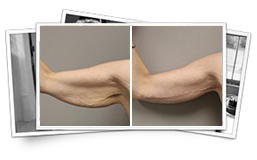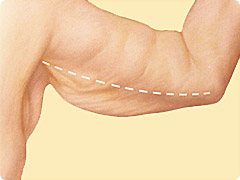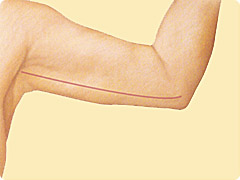Arm Lift Thousand Oaks
An arm lift, or brachiplasty is a surgical procedure for removing excess, sagging skin from the arms. This most commonly occurs after massive weight loss. Fat alone without skin excess can be treated with liposuction.
Before & After Photos
 Arm Lift
Arm Lift
At the Kryger Institute of Plastic Surgery, we have experience in a vast array of surgical and non-surgical procedures. Click below to see some before and after photos of arm lifts.
 The incision is made in the inner arm extending from the armpit to the elbow.
The incision is made in the inner arm extending from the armpit to the elbow.
The final scar is not visible when the arms are by the side of the body.
Who is a good candidate?
Women or men who have sagging, excess arm skin are good candidates. Other good candidates include massive weight loss patients (such as after gastric bypass), whose weight has been stable for over six months and are at their goal weight. Obese and significantly overweight patients with large amounts of fat in these areas are not good candidates for this procedure until they lose weight. Studies have shown that if your body mass index (BMI) is over 30, you are at much higher risk for developing complications from the surgery (or any surgery for that matter). Smokers must quit for 6 weeks before and 6 weeks after the surgery. If they do not quit smoking, there are significantly increased risks associated with the surgery.
Will insurance cover an arm lift?
No, insurance will not cover this procedure.
Preparing for surgery
Tell your surgeon about any medical problems you have, and any problems you may have had with surgery in the past. Inform him what medications you take-both prescription and non-prescription (including herbs and dietary supplements). You will be told which medications to stop and which to take before surgery. Aspirin and anti-inflammatory medications such ibuprofen and Alleve must be stopped for 7 days before surgery. The night before surgery you should shower and wash your armpits with antibacterial soap. Finally, you must strictly follow the instructions about when to start fasting before surgery (usually at midnight). If you get sick or have any health issues in the days before surgery, please notify the office at once in case we have to postpone your operation.
The surgery and the incisions
The operation itself takes about 2 hours, but can take even longer if you are undergoing additional procedures. The morning of surgery, your surgeon will answer any last minute questions you may have. He will mark the incisions on your arms. In most cases, the incisions are on the inner portion of the arm. Depending on how much skin must be removed, the incisions can extend almost from the elbow and into the armpit.
The anesthesia
An arm lift is usually performed under general anesthesia. In select cases it can be performed under “twilight” anesthesia in some cases. Twilight anesthesia consists of intravenous sedation and pain medication that keeps you relaxed and sleepy during the surgery. In addition, the surgeon uses local anesthesia to numb the region. General anesthesia involves going completely to sleep with a breathing tube in your throat. There is a slightly higher risk of nausea and vomiting after general anesthesia, however both techniques are extremely safe. Your surgeon will discuss the anesthetic options with you before surgery.
What kind of dressings and drains are there?
Your arms will be wrapped with ACE wraps after surgery. You can remove these wraps and the gauze dressings the day after surgery. The ACE wraps can then be worn directly on the skin for next 1-2 weeks. It is normal for a small amount of fluid to leak from the incisions for the first few days, especially if you have had liposuction. This fluid looks like “Cool-aid” or fruit-punch and is part of the normal healing process. If you have leaking fluid that persists more than 48 hours after surgery, call the office. If there is tape or adhesive strips directly on your incision, do not remove these. If they fall off in the shower there is no need for concern.
An arm lift may require that you have drains after surgery: These help drain the fluid that is produced under your skin as part of the healing process. Without drains, this fluid can accumulate, termed a seroma. The drains stay in until the drainage is less than 25 ml per drain in a twenty four hour period. This usually takes 1-2 days, but can be longer in some cases. The drains are easy to take care of, and do not hurt to take out.
Can you go home the day of surgery?
Most patients undergoing an arm lift alone can go home the day of surgery. If you are undergoing other procedures at the same time, you may choose to spend one or two nights in the hospital. Your surgeon may recommend this as well. Some patients just prefer to spend a night in the hospital if they have young children, or live alone and do not have any help at home.
How much pain is there after surgery?
Pain from an arm lift is highly variable, and ranges from minimal to moderate. It is worst in the first few days after surgery, but then it rapidly improves. It is impossible to predict a person’s expected pain. If you have done well with surgery in the past, you will likely be fine after this surgery. Our surgeons have a lot of experience treating pain, and have published scientific articles and written book chapters about anesthetics and pain control. They will do everything possible to minimize your pain and will utilize all the newest pain medication. Within a few days, most people’s pain is controlled with plain Tylenol or Motrin.
What about swelling and bruising?
Swelling and bruising are normal signs of the healing process. They occur after any surgery to varying degrees. Swelling peaks at about 48 hours, and then rapidly decreases. By the end of the first few weeks, 50 percent of the swelling is gone. By 6-8 weeks, a majority of the swelling has diminished. By six months, almost all the swelling is gone. Any remaining swelling is almost not perceptible. Bruising is worst the day after surgery and then rapidly gets better. It is usually gone by two weeks.
What restrictions are there?
You can shower the day after surgery, but you should not take a bath, use a hot-tub, or go swimming for at least two weeks. The first day after surgery is usually spent lying in bed or sitting in a chair. Most patients then begin walking around the house. By the end of the first week, you will probably be ready to leave the house for short trips and light walks. More vigorous walking and mild stretching exercises can be resumed about two weeks after surgery. Strenuous activities such jogging, aerobics, weight-training, sit-ups, and sex should not be done until 6 weeks after surgery. Also, you shouldn’t do any heavy lifting (over 10 pounds) during these 6 weeks.
When can I travel?
Traveling after surgery (air travel, long distance car trips, train rides, etc) should not be done before the drains are removed and you have had your first postoperative visit. Typically, this occurs 5-7 days after surgery. Patients who are at high risk for developing a blood clot should not travel until instructed by their surgeon. Short car trips under 60 minutes can be done before the first visit. A good rule of thumb is when you are off the stronger pain medication and can get up without assistance you are ready to go for a short drive. You should not drive the car yourself, however, until your surgeon gives you clearance for this.
When can I go back to work?
This, of course, depends on the kind of work you do. Most people go back to work after one week. Sedentary jobs, such as computer work or talking on the phone can begin even sooner. If you have a strenuous job that involves a lot of lifting or physical activity, you may have to wait 6 weeks until you are ready for work. Please review the restrictions for further guidelines about getting back to work.
What kind of scars can I expect?
Scarring is an unpredictable part of any surgery. It is impossible to cut through the full thickness of the skin and not have a scar. Our surgeons have published numerous scientific papers about the scarring process and wound healing, and will do everything possible to minimize scarring. To a large extent, however, scarring is determined by your genetics. If you are prone to hypertrophic (wide, raised) scars or keloids, make sure to inform your surgeon ahead of time. Our surgeons will use all the available techniques to minimize your scars based on their extensive research experience on hypertrophic scarring.
Your scars will be firm and pink for at least six weeks. After six weeks, scars are very strong and can withstand any activity. Then they may remain the same size for several months, or even appear to widen. After several months, your scars will begin to fade, although they will never disappear completely. It takes 1-2 years for a scar to completely heal. Make sure to apply sunscreen containing zinc-oxide to your scars for six months so that they do not darken due to increased pigmentation.
What if I have a problem? When should I call the office?
The Kryger Institute welcomes calls from patients. If you have any concerns at any time, please feel free to call our office. If it is an emergency, the answering service is available 24 hours a day, including weekends and holidays. There is always a plastic surgeon on call. Your surgeon will discuss all the risks and potential complications with you before surgery. You will receive detailed instructions about situations that warrant a call to the office.

